
The MSGraph Home Page
Overview |
Features |
Data Format |
System requirements |
Authors |
License |
How to get it
I forgot to give two more reasons to keep you working on MSGRAPH:
- the .MS file format compresses a lot better than mzXML or the RAW files.
- the eagle eye works a lot better than the Xcalibur software.
(Daniel Macedo Lorenzini)
Overview
MSGraph is a program designed for the interactive, fast, qualitative analysis
of mass spectrometric (MS) data. It is a tool to provide fast and simple
access to all the information contained in an LC/MS analysis run.
MSGraph was developed from 1992 onwards, and it was first published 1993
as a paper in Spectrochimica Acta [1].
Throughout the years (up to ~2004), I continued to use the program for my daily work, and
during that time I added some features that I found useful.
Probably the most important addition was the implementation of the component
detection algorithm (CODA) described by W. Windig in 1996 [2]. The version given here is a thoroughly revised, almost
completely re-written and in many details improved version of the initial program.
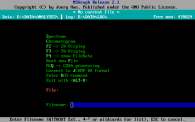 The main screen.
The main screen.

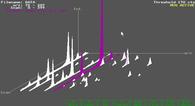 The "2D" screen (and, for completeness, a "3D" display).
The "2D" screen (and, for completeness, a "3D" display).
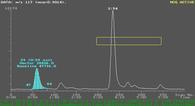
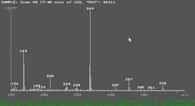 The CHRO and SPEC views.
The CHRO and SPEC views.
At a glance
- Call most functions directly, with a single keystroke or mouse click.
- Use the "eagle's view" (2D) display to visualise of all the information
of an analysis run: time, scan number, m/z and signal intensity at the
same time.
- Use CODA component detection algorithm to detect compounds and to perform
"intelligent" background subtraction.
- Zoom by a point-and-draw action of the mouse.
- Switch between all displays with just one mouse click or keystroke.
- Browse spectra and mass chromatograms with one keystroke or mouse click.
- Integrate mass chromatograms manually using the mouse.
- Keep track of "interesting" mass traces by writing them to file.
- Get graphical data in high-quality Postscript format, including color output.
- Save data - mass spectra, mass chromatogram, integration results and
even 2D - as ASCII files, e.g. for use with graphics or spreadsheet software.
- Convert data to JCAMP-DX format.
- ... and it is Free Software, published under Version 2 of the
GNU Public License (GPL)!
Using LC/MS, particularly using electrospray or thermospray as ionization technique,
often results in chromatograms with a high level of noise. Using conventional
background subtraction techniques or "differential chromatograms"
is of limited success. A dynamic selection procedure was developed by Windig
and coworkers [2] that selects mass
chromatograms with both low noise and low background; these selected chromatograms
are then combined to form a "reduced TIC" trace.
This is achieved by calculating a "similarity index" between
each raw mass chromatogram and its smoothed and mean-subtracted version. The
"similarity index" is called Mass Chromatogram Quality index (MCQ); a value
of 1 indicates a perfect match, values around 0.7...0.8 are usually still reasonable
chromatograms, and data with an MCQ index below 0.6 are usually not worth being
considered. Details are outlined in the reference cited above.
The approach is named COmponent Detection Algorithm (CODA). In LC/MS, it allows
to reduce the number of "useful" mass chromatograms by more
than an order of magnitude without losing significant information, and it results
in a large reduction in data analysis times.
MSGraph does CODA processing somewhat different from some commercial packages
(that I am aware of): Once the MCQ values are determined, there is no need
to re-run CODA processing if you want to modify the threshold. MSGraph does
not perform a "data reduction" of the original data file; all data are
always there, are never modified, and the MCQ threshold value be adjusted anytime.
The following figures show a few examples of "raw data vs. CODA-processed data".
By clicking on the preview images you can download a PostScript file of the
original graphics. By the way, these files are as exported by MSGraph and
were not altered in any way later on.
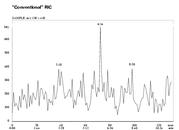

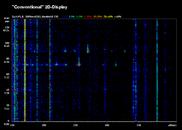

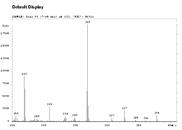
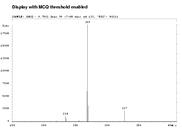
For historical reasons, the program is designed to read data files in a proprietary, yet simple format;
a detailed description of the file format is included. Other data must be converted to this format.
Ready-to-use converters are available for the following formats:
- cdf2msg, a utility to convert .CDF (aka "ANDI-MS") data files to MSGraph compatible format.
- mzXML2msg, a utility to convert
mzXML data files
to MSGraph compatible format. Contributed (thanks a lot!) and maintained by
Daniel Lorenzini.
- ep2msg, an old utility to convert files in the (outdated) .EP format to MSGraph compatible format.
Exporting and Printing Data
- Postscript output:
From the SPEC, CHRO and 2D display, files in Encapsulated Postscript (EPS) format
can be generated. These files can be imported into any reasonable word processing
software, or printed directly.
- HPGL output:
From the 2D display, files in HPGL format can be generated.
- ASCII output:
From almost any screen, data can be exported as plain-text ASCII files and then
imported into spreadsheet/graphics software. The files generated by MSGraph
are, by default, standard TAB-delimited ASCII files that are read directly by
nearly any software package, but the format can be customized if necessary.
- report is a tool to convert MSGraph's integration result files into "human readable" format.
The program runs under using MS-DOS and can be used in a "DOS box" of at
least Microsoft Windows 3.11, 95b, 98, NT4, and 2000.
However, the program has to be opened full screen, and the "DOS Window"
apparently causes severe load on the operating system, which means that
e.g. playing MP3 files simultaneously is no longer a pleasure for your ears.
It runs nicely, even in the high-resolution graphic modes, under Linux
DOSEMU. This implies that you can visualize your data with MSGraph even if
you are actually sitting on a Unix machine, as the window running MSGraph can
be redirected to any other X display!
A standard graphic driver for standard VGA is implemented, which should work
on all systems. A VESA compliant SVGA driver for higher screen resolutions
(up to 1280x1024) is provided, but its proper function depends on the operating
system.
Detailed instructions for installation, operational qualification testing, and maintenance are provided.
 MSGraph running under Linux DOSEmu (KDE1).
MSGraph running under Linux DOSEmu (KDE1).
MSGraph is considered stable and mature.
The software is fully operational and there are no plans for further development.
MSGraph and all related software are Free Software
and are published under Version 2 of the
GNU General Public License (GPL).
You can redistribute it and/or modify it under the same terms, which ensures that its source code is free and that
any derivatization, or implementation of it in other software, will also remain free.
The difference between "free software" and "freeware" is of legal importance. If you do not understand
any portion of this license, please seek appropriate professional legal advice. If you do not or if - for any
reason - you can not accept all of the conditions of the GPL, then you must not use nor distribute
this software.
Since early 2009, this software is hosted at sourceforge.net.
To download, you have several possibilities:
- Visit the Sourceforge project page.
- If you have a subversion client installed, run svn checkout https://svn.code.sf.net/p/msgraph/code/ msgraph
The principal author is Jörg Hau.
Contributions - be it with suggestions, testing, discussions or code - came from many people,
namely Michael Linscheid who supported to develop this program "seriously", and Walter Nigge who gave
many little hints and performed much testing especially in the early years of the development.
Thanks go also to Daniel Lorenzini for the development of the mzXML converter,
and to many others that have sent constructive feedback over the years.
Thank you!
[1]
J. Hau and M. Linscheid. MSGraph: A Program for the Display of LC/MS Data.
Spectrochimica Acta 48B (1993), E1047-E1051.
[2]
W. Windig, J. M. Phalp, A. W. Payne.
A Noise and Background Reduction Method for Component Detection in Liquid
Chromatography/Mass Spectrometry. Analytical Chemistry 68 (1996), 3602-3606.











